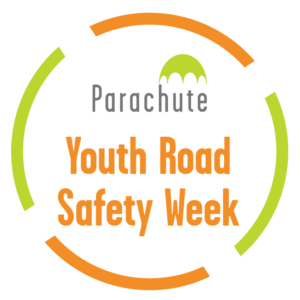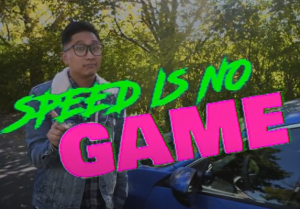
This awareness week, formerly known as National Teen Driver Safety Week (NTDSW), takes place from October 20 to 26, 2025 with the theme #OurFutureRoads.
We have shifted our awareness week focus to encompass all youth road users, including drivers, passengers, pedestrians, cyclists and transit users, with the goal of empowering youth ages 15 to 24 to become more involved in road safety issues, to create and support road systems in our communities that are safe and equitable. Read more about why we have moved from National Teen Driver Safety Week to Canadian Youth Road Safety Week in this article, What’s in a name? Plenty!
Support the week using our Social Media Guide and supporting images.
Our future roads: Safety is not a fairy tale
Once upon a time, the idea of truly safe roads might have seemed like a fairy tale. We wish we could walk or bike more, we wish we had more options than driving, we wish we could feel safer. But here’s the good news: we don’t need magic to make safe roads a reality.
Proven strategies exist that can dramatically reduce injuries and deaths, creating roads where everyone can travel safely, and youth have a vital role in bringing this change to life.
Road crashes are the third-leading cause of death among young people aged 15 to 24 in Canada, making youth some of the most vulnerable on our roads. But as young people inherit the transportation systems being built today, they also have the power to reshape them. Their voices, ideas and actions are essential to making our streets safer.
Snap for change
Through our key activity, Snap for Change, Parachute invites people of all ages across Canada to share their voices and advocate for road safety measures in their communities. Together, we can make safe, sustainable and inclusive roads a reality.
Is there an area in your neighbourhood that feels unsafe to walk, bike, scooter or drive? Maybe it’s an intersection with poor visibility or a street without sidewalks and pedestrian crossings, or an area where the speed limit is higher than 30 km/h. Maybe you would love to bike to the grocery store or to see your friends, but there aren’t enough separated bike lanes on your route.
Share your voice with us by joining the Snap for Change Initiative! Take a picture of the problem area, tell us what you think would make this area safer, and receive a $100 gift card for your submission. Safe roads are not a fairy tale – your voice matters and together we can make our future roads safe for all.
Factors that make roads safer and proven measures to protect young people
Safe speeds
Speed is a factor in around a quarter of fatal crashes. A pedestrian hit at 50 km/h is six times more likely to die than if hit at 30 km/h.
Proven measures that don’t need fairy dust:
- Keeping speeds at 30 km/h in areas where people walk, cycle and play.
- Traffic calming measures such as speed bumps, roundabouts and road narrowing to ensure that speeds remain low.
Active transport
Walking, cycling and scooting are great ways to boost our health and reduce emissions – but we need to be able to do it safely. Youth are more likely to choose active transport when roads are built to keep them safe.
Measures that turn a quest into a choice:
- Separated bike lanes reduce injuries and deaths by up to 90 per cent.
- Pedestrian pathways and transit connections make active travel an easy choice.
Public transit access
Cars and trucks produce 40 per cent of Canada’s transport emissions – public transit can help change that. Forty per cent of low-income residents on big cities lack access to jobs, healthcare and more. For rural and northern areas, this is an even bigger challenge.
Measures that don’t need magic wands:
- Expanding transit options to make travel safer and more equitable for youth.
- More transit means fewer collisions, less pollution and greater access for all.
Impaired driving
Impaired driving remains one of the leading causes of preventable crashes.
No potions, just prevention:
- Harm reduction methods such as designated drivers, rideshare access and public transit can prevent impaired driving.
- Youth can raise awareness of these strategies and encourage their peers to choose safe options.
Smart design
Safety isn’t a fairy tale, and neither is the power of smart design:
- Lower speeds cut emissions and make streets safer for everyone.
- Public transit access gives more people options and reduces car use.
- Separated bike lanes keep cyclists safe and encourage more active travel.



